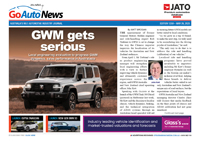News - Ford - Falcon - ForteFalcon tops safety ratingsNo crash test dummy: The Ford Falcon ranks as Australia's safest family car in the latest ANCAP crash test results. Local crash testing shows Australian large car safety is improving30 May 2001 By JUSTIN LACY AUSTRALIAN family cars are closing in on the safety levels of their European counterpartsm, according to the latest round of independent crash tests conducted by the Australasian New Car Assessment Program (ANCAP). The Ford Falcon has emerged as the leading Australian-built car in terms of crash protection for occupants, ahead of Toyota's Camry and Avalon models, Mitsubishi's Magna and the Holden Commodore. The Falcon scored three out of a possible five stars and was only just short of a four-star result, placing it within a few points of the European NCAP test result for the Mercedes-Benz E-class. "The Falcon result, which has not been subjected to the pole test, is almost at the same level as the Mercedes-Benz E-class result from Euro NCAP, which did have a pole test," RACV chief engineer Michael Case said. "It just so happens the Falcon is at the top of three stars and the E-class is just at the bottom of four stars, so there is not much difference between them." Two extra points are on offer in the pole test, but in order to be eligible vehicles must be fitted with a side or curtain airbag that specifically offers head protection in a side impact crash - not just thorax protection. All the other vehicles tested scored three stars as well, with the Camry's result also edging towards the four star zone, while Avalon, Magna and Commodore were in the lower reaches of the three-star classification. Australian NCAP star ratings combine each vehicle's performance in an offset frontal impact test against a deformable barrier at 64km/h and a side impact test at 50km/h. The vehicles were also subjected to a pedestrian test that indicates likely injuries to pedestrians hit by a vehicle travelling at 40km/h. They all achieved two out of a possible four stars in this test, which is on a par with the best European cars. "I think these vehicles are relatively good performers in terms of occupant protection performance, but there is obviously some further area for improvement to get them four stars and ultimately five," Mr Case said. "Obviously the more stars the better, but our recommendation would be that people choose vehicles with at least three stars against them." The Falcon has shown substantial improvement since the last batch of large cars was tested in 1999, when its performance was ranked below most of its competitors. "I suspect that Ford has done a lot of work on Falcon and I believe AU II results show that work," Mr Case said. "I think it is certainly structural in terms of the front of the car, but also the B-pillar as well. "The offset frontal test we did this time is the same test we did on the previous version, so we know the Falcon has improved. Ford have done a lot of work, they just haven't publicised it." As part of the AU II facelift, Ford added a laminated firewall to the Falcon as well as fitting dual front airbags as standard. These safety improvements have helped to lift its performance in the ANCAP crash tests to lead its rivals in the large family car class. Each car was tested in base grade specification, meaning Forte and Executive for the Falcon and Commodore models respectively. They all now offer airbag technology to consumers, with a driver airbag as standard in the Camry, Magna and Commodore and the addition of a front passenger airbag as standard in the Falcon and Avalon. ANCAP is closely aligned with the European NCAP crash test format and procedures, having moved away from its test links with the US Insurance Institute for Highway Safety over the past few years. It is supported by all Australian and New Zealand motoring clubs, the NSW, South Australian, Queensland and Western Australian state governments, and the Australian and New Zealand federal governments. The motoring clubs fund the crash tests, with each individual result costing about $150,000 - consisting of the purchase of two examples of the car being tested and the cost of the three crash tests. The Federal Chamber of Automotive Industries (FCAI) issued its standard rebuttal of the ANCAP findings. "The idea of providing meaningful occupant protection information to consumers has much merit. However, to be meaningful, the information provided to consumers must be relevant, accurate and comprehensive," FCAI chief executive Peter Sturrock said. The FCAI believes that ANCAP ratings do not meet these criteria and are therefore potentially misleading to consumers. The manufacturers are invited to witness the ANCAP tests and receive the results straight afterwards. The tests are conducted at Crashlab in Sydney, which is a specialist crash test facility that is part of the Road Traffic Authority (RTA). It is also used by the car manufacturers for their own vehicle testing. ANCAP and local car-makers will meet for a discussion on the test results at an industry briefing to be held at the end of July. "Our intention is to be completely transparent, so they always know what programs we're doing in terms of which group of vehicles, which models, what tests and if there is any changes to the test regime," Mr Case said. The next round of ANCAP crash tests will cover work utes, including the Falcon and Commodore-based models. The vehicles will be ordered in the next few weeks and tested between July and October. Results will be announced in December. The test results are: Combined Offset Frontal Impact & Side Impact CrashAustralian Vehicle Model Ford Falcon *** Toyota Camry *** Toyota Avalon *** Mitsubishi Magna *** Holden Commodore *** European Vehicle Model Renault Laguna ***** Saab 9-5 **** Volvo S80 **** Mercedes-Benz E-class ****Pedestrian ImpactAustralian Vehicle Model Ford Falcon ** Toyota Avalon ** Holden Commodore ** Toyota Camry ** Mitsubishi Magna ** European Vehicle Model Renault Laguna ** Saab 9-5 ** Volvo S80 ** Mercedes-Benz E-class ** |
Click to shareFord articlesMotor industry news |














Facebook Twitter Instagram